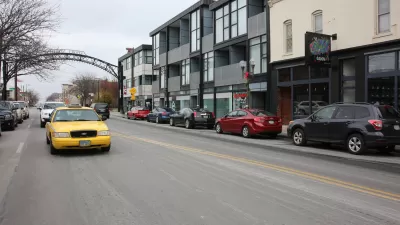A pair of articles from the Twin Cities, revealing the racist motivations of exclusionary zoning.

Discussions about neighborhood character, and zoning codes used to protect it, have the same effect as racial covenants, according to an article by Gretchen Brown.
While zoning codes often specifically state the desire to protect neighborhood character, such as an example cited from St. Paul, Minnesota, it's often wealthy, white homeowners who decide what neighborhood character means, and how and when to use zoning to protect it, according to Brown.
"While wealthy communities were able to use zoning to their advantage — preserving their property values, and controlling development of schools and businesses, poor communities of color are often burdened by what's called "expulsive zoning," living next to industrial and hazardous waste sites and landfills, and without access to public parks and grocery stores," writes Brown, before citing examples from cities like St. Paul and Charleston, South Carolina.
Brown is writing in St. Paul, where a majority of residents are renters, and where the neighboring city of Minneapolis recently took the ambitious step to ban restrictive single-family zoning in the entire city to counteract the status quo of zoning that protects wealthy, entrenched, white interests at the expense of other groups.
Despite Minneapolis' recent actions to overcome its legacy of racism by ending single-family zoning as an exclusionary tool in residential neighborhoods, the city has a long history of racist practices, as detailed in another recent article, this one by Julian Agyeman.
The article by Agyeman focuses in particular on the work of the University of Minnesota’s Mapping Prejudice project, which is devoted to "shedding new light on the role that racist barriers to home ownership have had on segregation in the city."
But Agyeman also has expertise to bring to the table to supplement the insights offered by Mapping Prejudice about the racist tradition of planning and zoning in the United States:
As a scholar of urban planning, I know that Minneapolis, far from being an outlier in segregation, represents the norm. Across the U.S., urban planning is still used by some as the spatial toolkit, consisting of a set of policies and practices, for maintaining white supremacy. But urban planners of color, especially, are pointing out ways to reimagine inclusive urban spaces by dismantling the legacy of racist planning, housing and infrastructure policies.
Both of these article were published in the wake of the civil unrest that has responded to the killing of George Floyd by police officers in Minneapolis, so the local situation is obviously informative of the broader discussion happening about how the planning status quo contributes to racism.
Both articles were published before, however, a series of tweets by president Trump explicitly stated the worst exclusionary and discriminatory motivations of traditional zoning practice in the United States.
FULL STORY: How Discussions of 'Neighborhood Character' Reinforce Structural Racism

Alabama: Trump Terminates Settlements for Black Communities Harmed By Raw Sewage
Trump deemed the landmark civil rights agreement “illegal DEI and environmental justice policy.”

Planetizen Federal Action Tracker
A weekly monitor of how Trump’s orders and actions are impacting planners and planning in America.

The 120 Year Old Tiny Home Villages That Sheltered San Francisco’s Earthquake Refugees
More than a century ago, San Francisco mobilized to house thousands of residents displaced by the 1906 earthquake. Could their strategy offer a model for the present?

In Both Crashes and Crime, Public Transportation is Far Safer than Driving
Contrary to popular assumptions, public transportation has far lower crash and crime rates than automobile travel. For safer communities, improve and encourage transit travel.

Report: Zoning Reforms Should Complement Nashville’s Ambitious Transit Plan
Without reform, restrictive zoning codes will limit the impact of the city’s planned transit expansion and could exclude some of the residents who depend on transit the most.

Judge Orders Release of Frozen IRA, IIJA Funding
The decision is a victory for environmental groups who charged that freezing funds for critical infrastructure and disaster response programs caused “real and irreparable harm” to communities.
Urban Design for Planners 1: Software Tools
This six-course series explores essential urban design concepts using open source software and equips planners with the tools they need to participate fully in the urban design process.
Planning for Universal Design
Learn the tools for implementing Universal Design in planning regulations.
Clanton & Associates, Inc.
Jessamine County Fiscal Court
Institute for Housing and Urban Development Studies (IHS)
City of Grandview
Harvard GSD Executive Education
Toledo-Lucas County Plan Commissions
Salt Lake City
NYU Wagner Graduate School of Public Service





























